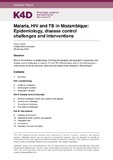Malaria, HIV and TB in Mozambique: Epidemiology, Disease Control Challenges and Interventions
Abstract
Malaria, HIV and tuberculosis (TB) are significant public health concerns in Mozambique. Malaria was the fourth leading cause of death in the country in 2019, accounting for 42% of deaths among children under 5 years of age (Mugabe et al., 2021; USAID, 2018). Mozambique is among the top eight countries with the highest HIV prevalence; with the second highest mother-to-child transmission (MTCT) rate in the world (Fuente-Soro et al., 2021; Nacarapa et al., 2021). The incidence of TB is rising, with pediatric TB cases almost tripling in recent years (WHO, 2020b; Nguenha et al., 2018; Orlando et al., 2018). Mozambique has one of the highest global incidence of malaria-HIV and TB-HIV co-infection, which raises the likelihood of poor clinical outcomes (Moon et al., 2019; USAID, 2018). This rapid literature review highlights key aspects of the epidemiology of malaria, HIV and TB in Mozambique and challenges in prevention, detection and treatment; and surveys select interventions that seek to address these challenges.
This is part of a series of reports looking into Epidemiology of Malaria, human immune deficiency virus (HIV) and tuberculosis (TB) across a set of African Nations.
Citation
Haider, H. (2022). Malaria, HIV and TB in Mozambique: Epidemiology, disease control and interventions. K4D Helpdesk Report 1088. Brighton, UK: Institute of Development Studies. DOI: 10.19088/K4D.2022.035DOI
10.19088/K4D.2022.035Is part of series
K4D Helpdesk Report;1088Rights holder
© Crown copyright 2022Sponsor
Foreign, Commonwealth and Development Office (FCDO)Collections
- K4D [937]

